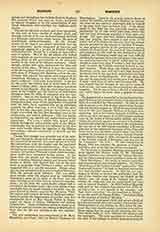

Manila Observatory, founded by Father Frederic Faura, S.J., in 1865; constituted officially “The Philippine Weather Bureau” by decree of the American governor, May, 1901.
The typhoon, known in the Philippines as a baguio, is one of the worst enemies with which the islands have to contend. Father Faura, a Jesuit professor at the Ateneo College, spent many years in the study of these dreaded storms, in the hope of one day being able to foretell their coming and thereby avert much of the damage which they would otherwise cause. On July 7, 1879, he predicted that a baguio would pass over Northern Luzon; the event justified his warning. It was the first time that the existence, duration, and course of a typhoon had been predicted in the Far East. On November 18 of the same year, Father Faura predicted a second typhoon, which he said would pass through Manila. The announcement caused great consternation in the city. Proper precautions were taken, and the captain of the port forbade vessels to leave the harbor. Thanks to the warning of Father Faura, comparatively little damage was done in Manila when, two days later, the storm broke in all its fury on the city. At other ports, to which notice of the approaching storm could not be sent for lack of telegraphic communication, the destruction was enormous. Forty-two vessels were wrecked in Southern Luzon alone, and many lives were lost.
These successful predictions aroused the interest of a number of merchants of the city, who subscribed money to enable him to continue his valuable work on a larger scale. In 1880, when cable connections between Hong-Kong and Manila were established, the merchants of the former colony requested that Father Faura’s predictions be sent them; and their request was cheerfully granted. For some time the Jesuit meteorologist had been working on a barometer of his own invention, specially designed to foretell the approach of baguios. In 1886 the “Faura barometer” was offered to the public, and it passed immediately into general use among the navigators of the Philippine waters and the China Sea. In 1884 the Government at Madrid declared Father Faura’s weather bureau an official institution, to be known as the Manila Observatory. It was then removed from the Ateneo to its present location in the District of Ermita, Manila. Fourteen substations, each equipped with suitable meteorological instruments, were now opened in Luzon, and their daily observations were published in a monthly bulletin. In 1890, at the request of the Japanese Government, observations began to be exchanged with that country. In 1895 the Manila Observatory was invited to be one of sixteen observatories of the world to cooperate in the work of cloud-measurement, and it succeeded in making the highest of these measurements. The photographic observations were carried on by the Rev. Jose Algue, S.J., who is now director of the Philippine
Weather Bureau. Father Algue published a valuable work, “The Clouds in the Philippine Archipelago”, as the result of his observations. His “Philippine Cyclones”, a volume much prized by navigators, and which has been translated into several languages, was published in 1897. In the same year he gave the public his “barocyclonometer”, an improvement on Father Faura’s invention, by which storms may be foretold, not only in the Philippines, but throughout the entire Orient.
The meteorological service of the Philippines was reorganized by Father Algue. The observatory at Manila receives observations by telegraph three times a day from eight first-class and nine second-class stations throughout the islands. Eighteen stations of the third class telegraph their observations twice a day while ten fourth-class stations record observations and telegraph on request. The observatory has a branch at Mt. Mirador, about 5000 feet above sea level, which telegraphs its observations three times a day. reports are also received twice each day by cable, from ten stations in Japan, from six in Formosa, from four on the Chinese coast, and from three in Indo-China. Whenever there are indications of a typhoon, cable-grams are exchanged with the stations m Guam and Yap, and on such occasions as many as half a dozen or more messages may be cabled on a single day to all the foreign stations. The observatory, besides a rich equipment of the latest meteorological instruments and seismographs, possesses a 19-inch refracting telescope, by far the largest in the Orient. It has also its own private telegraph and cable office. The staff of the observatory at Manila includes five Jesuit fathers and twenty-five well-trained native assistants.
PHILIP M. FINEGAN

